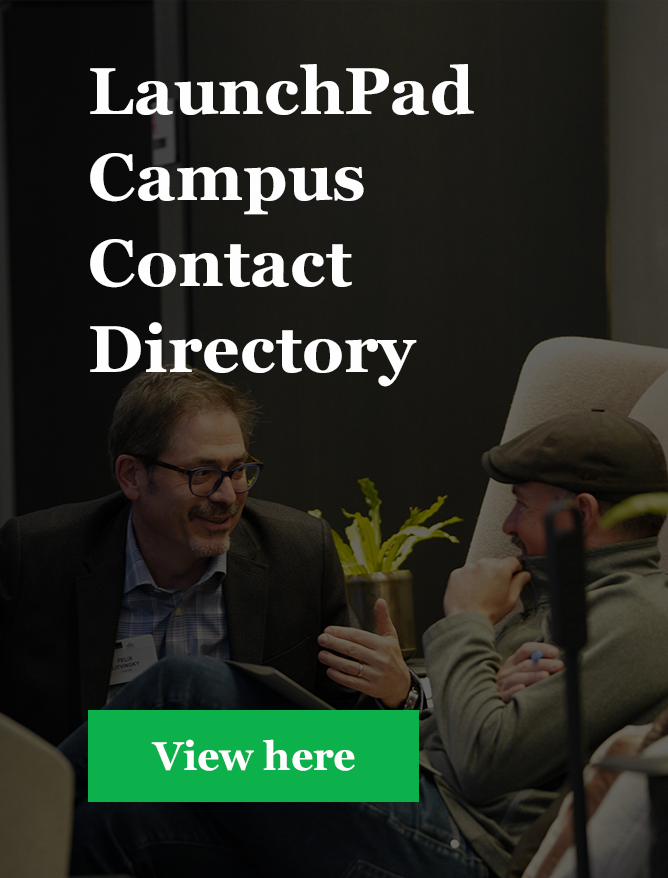Beyond additional funding and the strategic use of advisory councils, do you know how else your LaunchPad compares to other college or university-based entrepreneurship centers? From reporting structure to programmatic offering to constituencies served, knowing this kind of benchmark information can help you make better decisions.
Furthermore, when you share this kind of information with your school leadership, donors, community members, and other key stakeholders, they come to recognize you as an expert on the subject. In support of this goal, here are six metrics gathered from the Global Consortium for Entrepreneurship Centers (GCEC) 2019 survey. As you review this data, take a moment to consider how your operations compare, and whether any of the differences may present new opportunities for your center or your school.
- Is the leader of your center tenure/tenure-track faculty, non-tenure/adjunct faculty, staff or administration without a faculty appointment?

The employment arrangement of entrepreneurship center directors is fairly evenly split, with a slightly higher level for non-faculty directors. On one hand, this may free up staff time for more program planning and entrepreneur mentoring or coaching, however, it may also limit an important classroom-based opportunity to promote the non-academic services of a center. - To whom does your center report?

While a majority of center directors report to a dean, it is interesting that 20% report directly to either the president or a provost. Among respondents that selected “other”, “Vice Provost”, “Vice President of Research”, and “Director of Career Services” were some of the most commonly referenced administrative positions.
- Does your entrepreneurship center have a devoted physical space?
In “Startup Communities” Brad Feld highlights the fact that after an annual injection of, “new, young smart people come to town to be freshmen,” one of the next most important things universities can offer is a physical space for gathering. “Universities have great spaces to work, large conference and auditorium facilities, and lots of students and faculty interested in entrepreneurship.” As such (and in alignment with this critical component to the LaunchPad network), nearly 9 out of 10 centered surveys indicated that they offered a physical space which may include student workspace, faculty and staff offices, meeting rooms, etc. Depending on location and accessibility on campus, some LaunchPads may even be able to open their space to relevant outside groups (ex: entrepreneurship-focused Meetups, regional and national entrepreneurship conferences, civic and community meetings on the topic, etc.)
have great spaces to work, large conference and auditorium facilities, and lots of students and faculty interested in entrepreneurship.” As such (and in alignment with this critical component to the LaunchPad network), nearly 9 out of 10 centered surveys indicated that they offered a physical space which may include student workspace, faculty and staff offices, meeting rooms, etc. Depending on location and accessibility on campus, some LaunchPads may even be able to open their space to relevant outside groups (ex: entrepreneurship-focused Meetups, regional and national entrepreneurship conferences, civic and community meetings on the topic, etc.) - What constituencies does your entrepreneurship center serve?
The groups your center serves can have important implications on where funding and resources come from. For example, if a center serves a significant percentage of faculty or staff, it may be appropriate for some portion of the center’s budget to come from a professional development university allocation. Similarly, if the center supports a higher (or lower) percent of graduate students or alumni, this may impact what audiences are targeted for philanthropic giving. Those respondents who selected “other” defined these populations as “general public,” “angel investors,” and “other institutions.” Again, these audiences may result in important strategic adjustments to internal and external funding sources.
from a professional development university allocation. Similarly, if the center supports a higher (or lower) percent of graduate students or alumni, this may impact what audiences are targeted for philanthropic giving. Those respondents who selected “other” defined these populations as “general public,” “angel investors,” and “other institutions.” Again, these audiences may result in important strategic adjustments to internal and external funding sources. - What types of programming does your entrepreneurship center offer?

While the top four types of programming that nearly all entrepreneurship centers host are generally predictable and expected, it may be valuable to consider what “other” offerings these centers report. These included: Funding, Internships, Student Clubs, Hall of Fame and Awards, Company Visits, Travel, and Coworking Spaces. Each of these alternatives offers a unique set of opportunities, and challenges, and maybe right for different institutions and environments.
In terms of successful events, select text responses included:
- “Alumni Stories - bringing back three or four of our top alumni entrepreneurs to share their stories and meet students”
- “Social entrepreneurship weekend hackathon”
- “Venture crawl - student exploration of urban entrepreneurship (touring local startups/startups ecosystems)”
- “Introduction to intellectual property and negotiation workshops” - Does your entrepreneurship center work frequently with community (non-university) organizations?

Perhaps the most surprising fact about this final response is that the percent engaging with community organizations is not higher. This could either indicate a significant untapped resource, a lack of community resources, or that the university provides entrepreneurship centers more support than can be utilized.
In addition to these questions, the biannual GCEC survey asks many more and can serve as a valuable resource for informing your strategy and positioning you as a subject matter expert. The full 193-page survey export can be accessed here.






